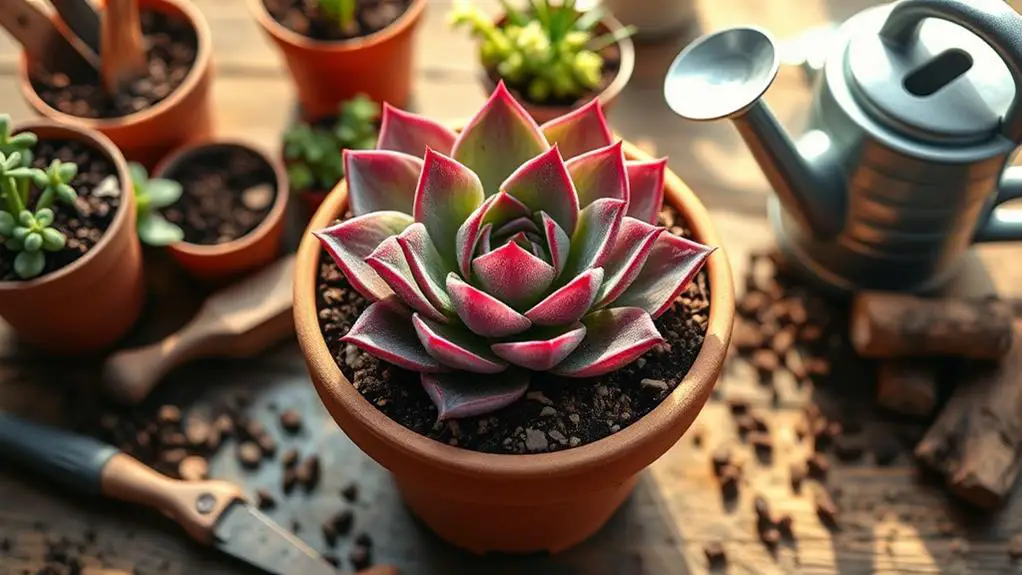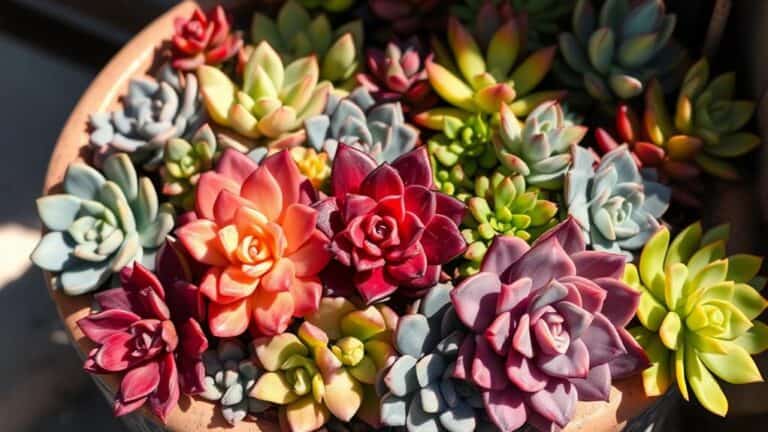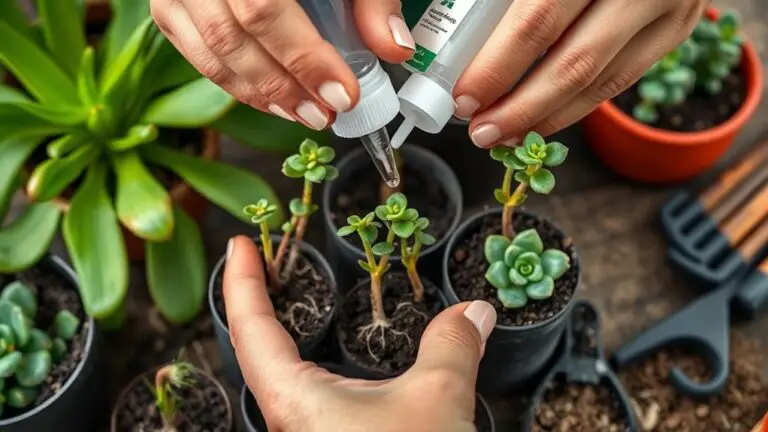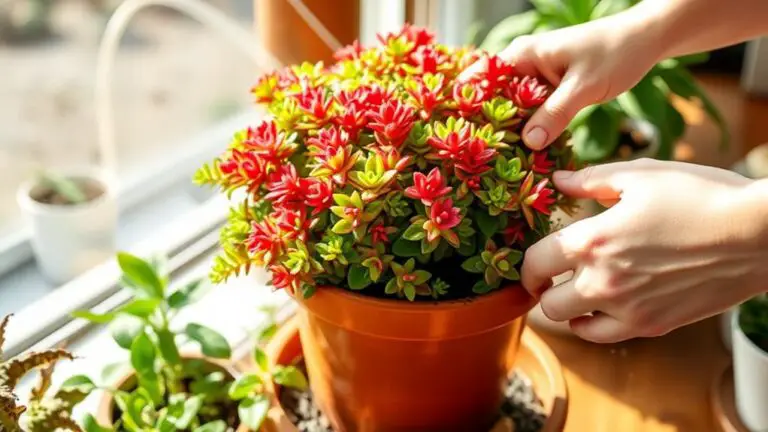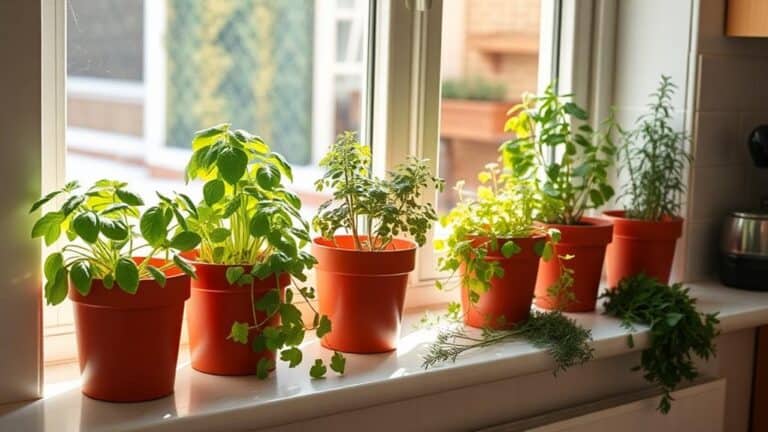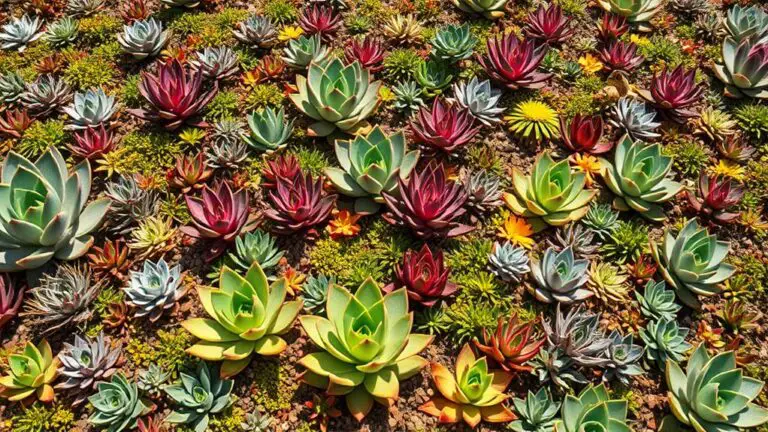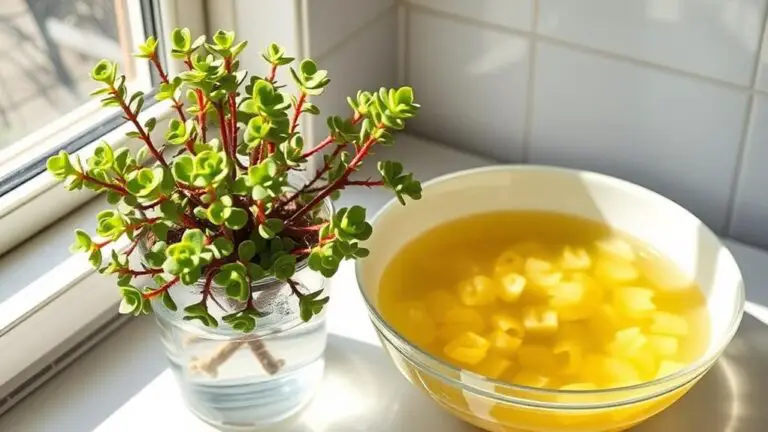Graptoveria Fred Ives: A Step-by-Step Care Guide
You're about to discover how to keep your Graptoveria Fred Ives thriving with ease. This stunning hybrid succulent, known for its colorful rosettes, requires specific growing conditions to maintain its vibrant appearance. From selecting the right soil to understanding its light preferences, each step is vital. Ready to transform your space with this adaptable plant? Let's explore the essential care techniques that will guarantee your Graptoveria Fred Ives stays healthy and beautiful.
Plant Identification
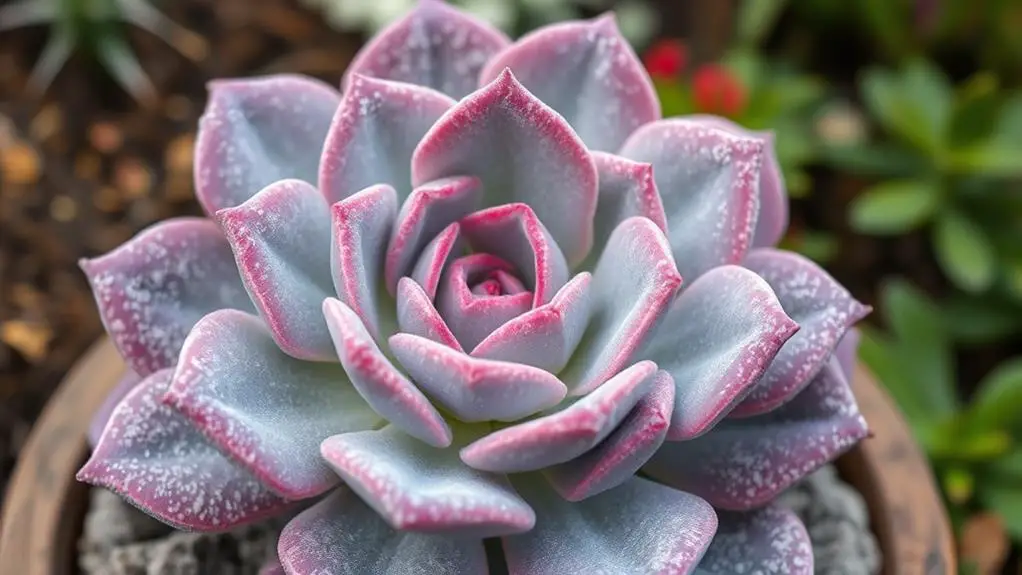
In the world of succulents, Graptoveria Fred Ives stands out for its striking and robust appearance. This hybrid succulent, formed from Graptopetalum paraguayense and Echeveria gibbiflora, is known for its attractive rosettes.
You'll find that it typically grows 4-8 inches tall and can spread up to 12 inches wide. The fleshy leaves exhibit vibrant colors like gray-green, pinkish-purple, and peach, making it a visual delight.
During the summer, small yellow, pink, or orange flowers bloom, adding to its charm. Recognized for its durability and resilience, Graptoveria Fred Ives is perfect for plant care novices and experts alike.
Its aesthetic appeal makes it a popular choice for decorative arrangements and landscaping projects.
Growing Conditions
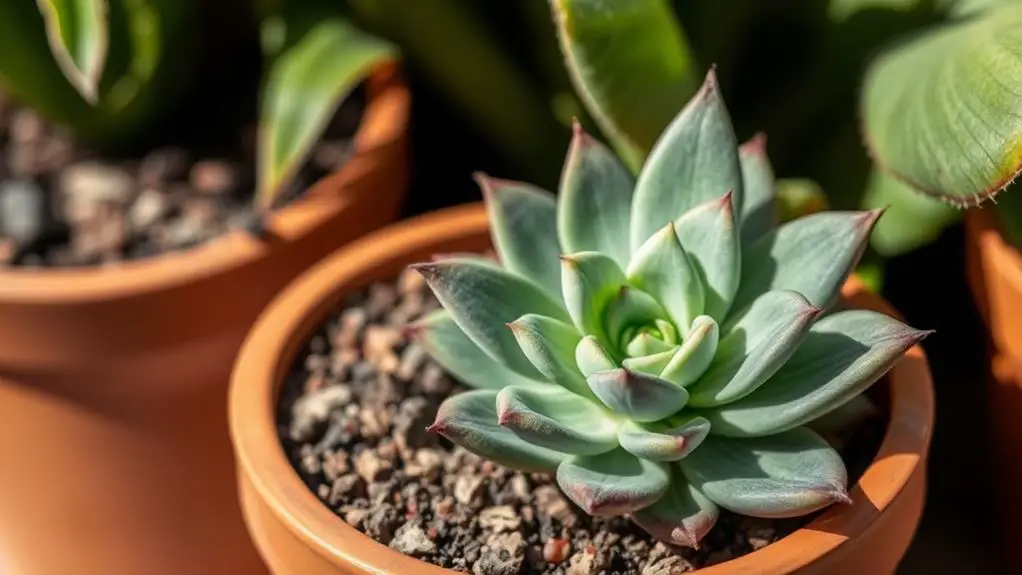
To guarantee your Graptoveria Fred Ives thrives, pay close attention to its growing conditions.
Start with well-draining soil. A cactus mix combined with extra perlite works best, ensuring the soil dries quickly between waterings.
Place your Graptoveria Fred in bright indirect sunlight, as it thrives under these conditions. It can handle some direct sunlight, particularly in cooler months.
Keep the temperatures between 65°F to 75°F (18°C to 24°C), and protect your plant from frost and temperatures below 45°F (7°C).
Graptoveria Fred prefers moderate to high humidity but can adapt to drier environments if you avoid overwatering.
Regularly monitor light exposure and temperature to maintain the plant's health.
With these tips, your succulent will flourish.
Care Techniques
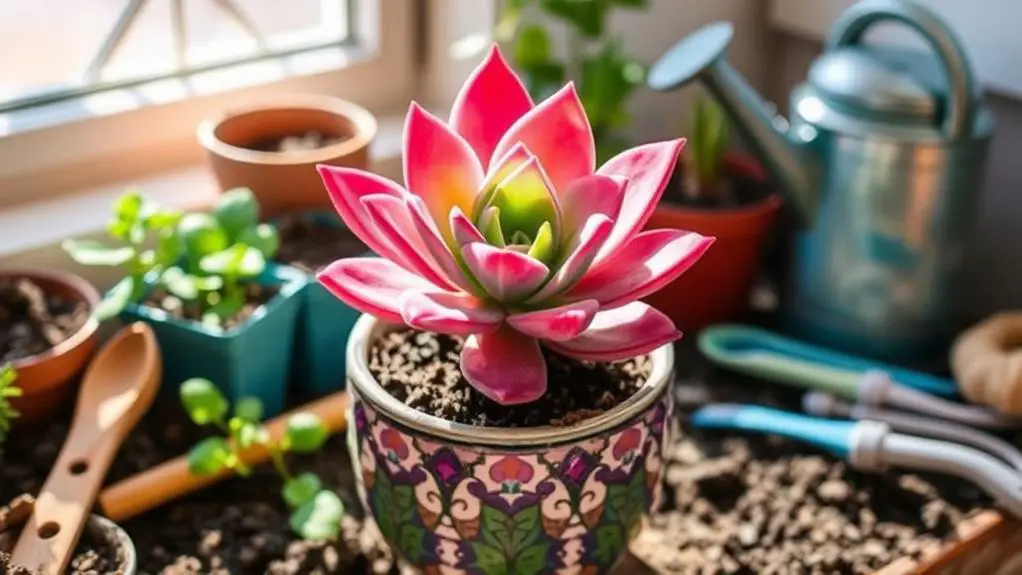
In caring for your Graptoveria Fred Ives, it's important to stay vigilant about pests like mealybugs and aphids, catching them early to keep your plant healthy.
Regular pruning helps it grow bushier and removes dead or damaged leaves, while repotting every 1-2 years keeps the soil fresh and gives roots more space.
Pest and Disease Monitoring
Keeping your Graptoveria Fred Ives healthy requires vigilant pest and disease monitoring. Regularly inspect your plant for common pests like mealybugs and aphids. These pests can cause significant damage if not treated.
Look for signs of fungal infections, such as leaf spots, which may indicate overwatering and poor air circulation. Address these issues promptly to maintain plant health.
Monitor for symptoms of root rot, like yellowing leaves and mushy stems, by checking soil moisture and ensuring proper drainage. Good ventilation around your plant minimizes the risk of disease, especially in humid conditions.
Use insecticidal soap or neem oil to treat pest infestations. Regular inspections help catch problems early, keeping your Graptoveria Fred Ives thriving.
Pruning and Repotting Practices
When it comes to maintaining your Graptoveria Fred Ives, pruning and repotting are essential practices that promote healthy growth and energy.
Start by pruning any dead or damaged leaves. This will encourage bushier growth and improve airflow around the plant.
Repotting should be done every 1-2 years. This refreshes the soil and provides more space for root growth.
Make sure the new pot has drainage holes and use a well-draining soil mix, like cactus soil with added perlite, to prevent root rot.
After pruning or repotting, let the plant rest for a week before watering.
Monitor for signs of distress, such as yellowing leaves, and address any issues quickly to keep your plant thriving.
Common Issues
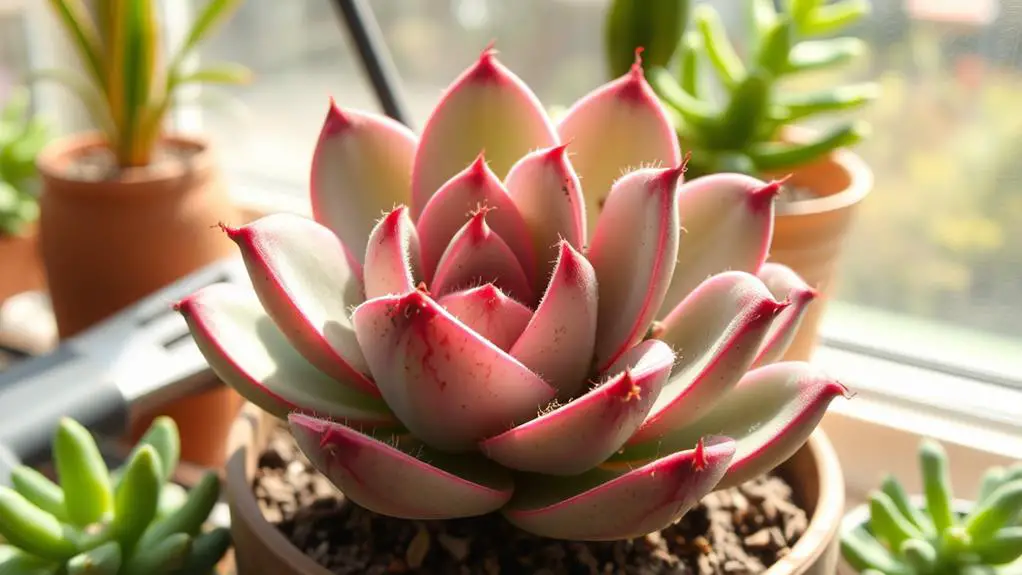
Graptoveria Fred Ives often confronts several common issues that can hinder its growth and significance.
Overwatering is a big problem, leading to yellowing and mushy leaves due to root rot. To avoid this, check the soil moisture regularly and water only when it's dry.
Leaf spots might appear from fungal infections caused by too much moisture. Improve air circulation around your plant to prevent this.
Pest infestations, such as mealybugs and aphids, can also affect your Graptoveria. Regularly inspect your plant and treat any pests with insecticidal soap or neem oil.
Uses and Symbolism
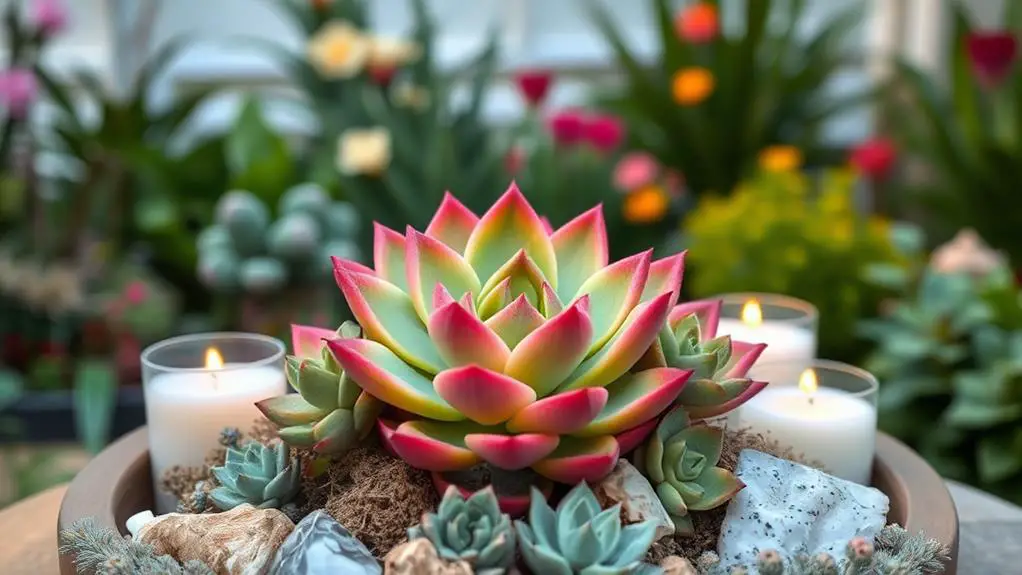
Graptoveria Fred Ives is a fantastic choice for adding a splash of color to your home, thanks to its vibrant hues and eye-catching rosette shape.
Beyond its beauty, this succulent symbolizes resilience and adaptability, making it a thoughtful gift for someone starting a new chapter in life.
Plus, it offers Feng Shui benefits by improving air quality and bringing a sense of balance to your living space.
Decorative Indoor Plant
As a decorative indoor plant, the allure of Graptoveria Fred Ives lies in its vibrant colors and unique rosette shape, making it a stunning centerpiece for any indoor space.
You'll love how it enhances decorative arrangements with its gray-green leaves that can shift to pink and peach under the right lighting. Not only is it beautiful, but it also offers indoor air purification benefits, adding a healthy touch to your home.
This plant's adaptability means it can thrive in various indoor environments, making it easy for you to care for. Whether you place it on a windowsill or a coffee table, Graptoveria Fred Ives will certainly add charm and freshness to your living area.
Symbolism in Succulents
In the world of succulents, symbolism plays a significant role, adding deeper meaning to the beauty of these plants.
Graptoveria Fred Ives symbolizes resilience and adaptability, making it a meaningful choice for anyone who values these traits. This succulent isn't just visually appealing; it also represents growth and care, making it a thoughtful gift for friends and loved ones.
When you incorporate Graptoveria Fred into your decorative arrangements, you're enhancing the aesthetic appeal of your space while also contributing to a healthier environment through its air-purifying qualities.
Its popularity in landscaping is no surprise, as it complements various garden designs beautifully. Embrace the symbolism of Graptoveria Fred and let its care enrich your living spaces.
Feng Shui Benefits
Building on the symbolism of resilience and adaptability, the benefits of Graptoveria Fred Ives extend into the domain of Feng Shui, where it's believed to attract prosperity and harmony.
This succulent's vibrant foliage brings vibrant energy and creativity to your space, enhancing not just the aesthetics but also the spiritual ambiance. By adding a Graptoveria Fred to your home, you're not just decorating—you're also inviting a sense of balance and positive energy.
Additionally, as an indoor plant, it aids in air purification, improving indoor air quality and making your living space healthier.
Embrace this beautiful, adaptable plant to create a calming environment that supports both your well-being and your Feng Shui intentions.
Watering Requirements
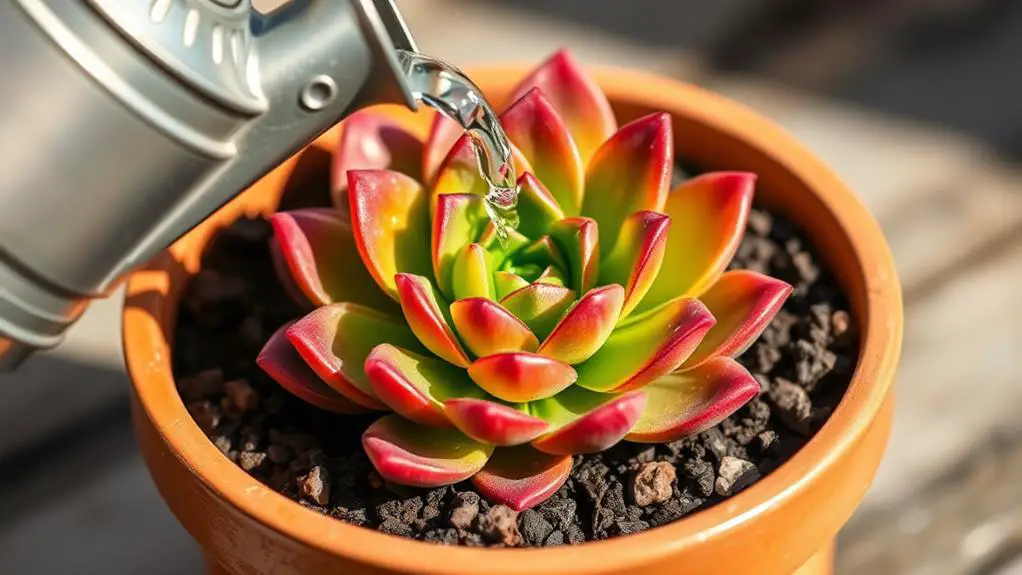
Watering Graptoveria Fred Ives correctly is essential for maintaining its health and vibrancy.
You'll need to let the top layer of soil dry out completely before watering again, which is usually every 12 days. During the summer, when the plant is actively growing, you might need to water a bit more often.
However, always guarantee that your soil mix is well-draining and that any excess water drains away quickly to avoid root rot.
In winter, reduce watering since the plant needs less moisture during its dormant period.
Remember to empty the saucer after watering to prevent pests and other issues.
Soil and Planting Conditions
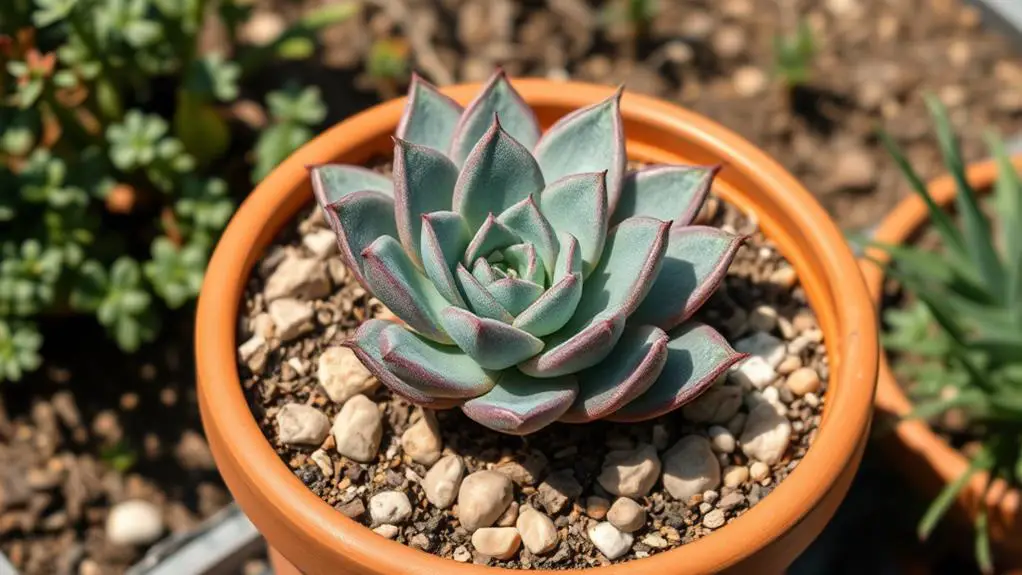
For your Graptoveria Fred Ives, using a well-draining cactus soil mixed with extra perlite is key to preventing root rot.
Make sure to let the soil dry out completely between waterings to keep your plant healthy.
Repotting every 1-2 years helps refresh the soil and gives your succulent room to grow, especially if it's doubled in size.
Ideal Soil Composition
A critical element for thriving Graptoveria Fred Ives is well-draining soil, which combines a cactus mix with additional perlite to boost drainage.
This type of soil guarantees that water doesn't linger, preventing root rot. You'll want the soil to dry out quickly between waterings. Repotting every 1-2 years helps refresh the soil and provides necessary nutrients.
- Soil Mix: Use a cactus mix with extra perlite for better drainage.
- Drainage: Always use pots with drainage holes to avoid moisture retention.
- Soil pH: Aim for slightly acidic to neutral soil, around 6.0 to 7.0.
- Repotting: Refresh soil every 1-2 years to keep your plant healthy.
Planting and Repotting Tips
Proper planting and repotting are pivotal to the health of your Graptoveria Fred Ives.
Start by choosing a cactus soil mix enriched with extra perlite for excellent drainage. This prevents root rot, which can be a serious issue.
When planting, make sure your pot has drainage holes to let excess water escape.
Repotting should be done every 1-2 years or when the plant doubles in size. This refreshes the soil and gives your plant room to grow.
Allow the soil to dry out completely between waterings; check the top layer to decide when to water.
When placing the plant in soil, avoid burying the stem deeply to prevent stem rot.
Follow these tips for a healthy, happy plant!
Temperature and Light Preferences

When caring for Graptoveria Fred Ives, it's important to provide the right temperature and light conditions to guarantee ideal growth.
This succulent loves bright, direct sunlight, so placing it less than one foot from a south-facing window is perfect. However, you'll need to monitor and adjust based on your climate to avoid sunburn.
Understanding its temperature preferences is key; it thrives between 20°F and 80°F but needs protection from frost. Insufficient light exposure can hinder its health, so keep an eye on light levels, especially during seasonal changes.
- Position in bright, direct sunlight
- Monitor for sunburn and adjust accordingly
- Maintain temperatures between 20°F and 80°F
- Provide bright indoor lighting during winter months
Propagation Methods
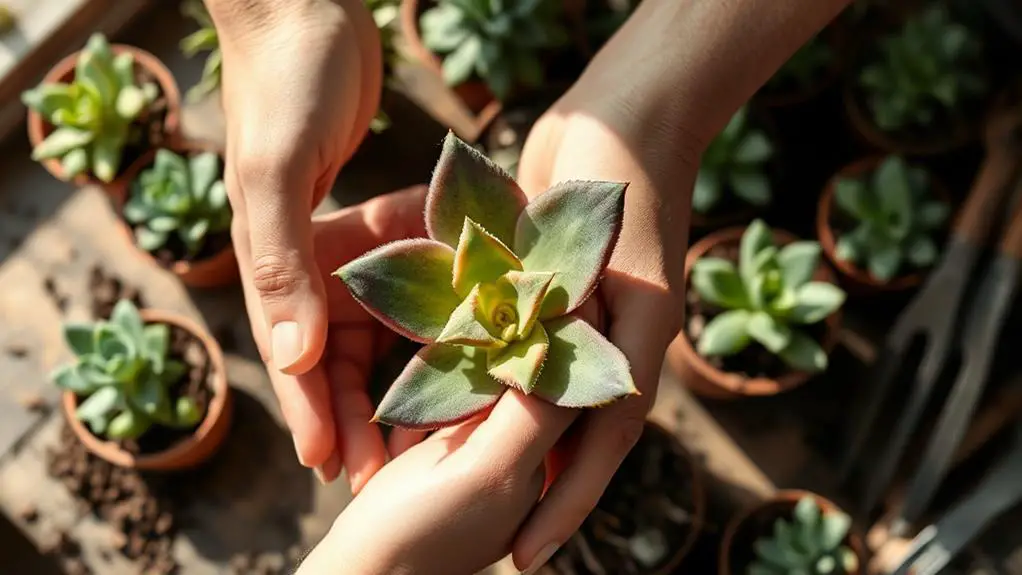
While ensuring Graptoveria Fred Ives receives ideal light and temperature conditions, you might also consider expanding your collection through propagation.
To propagate Graptoveria Fred, you can use stem cuttings, leaf cuttings, or offsets. For leaf cuttings, gently twist a healthy leaf from the stem, let it callous for several days, then plant it in well-draining soil.
When using stem cuttings, make sure to use clean, sharp tools, and allow the cut ends to dry for a few days to prevent rot before replanting. Offsets can be carefully removed from the parent plant and replanted.
Propagation works best in spring and summer when the plant is actively growing, with roots forming in 2-4 weeks.
Fertilization Guidelines
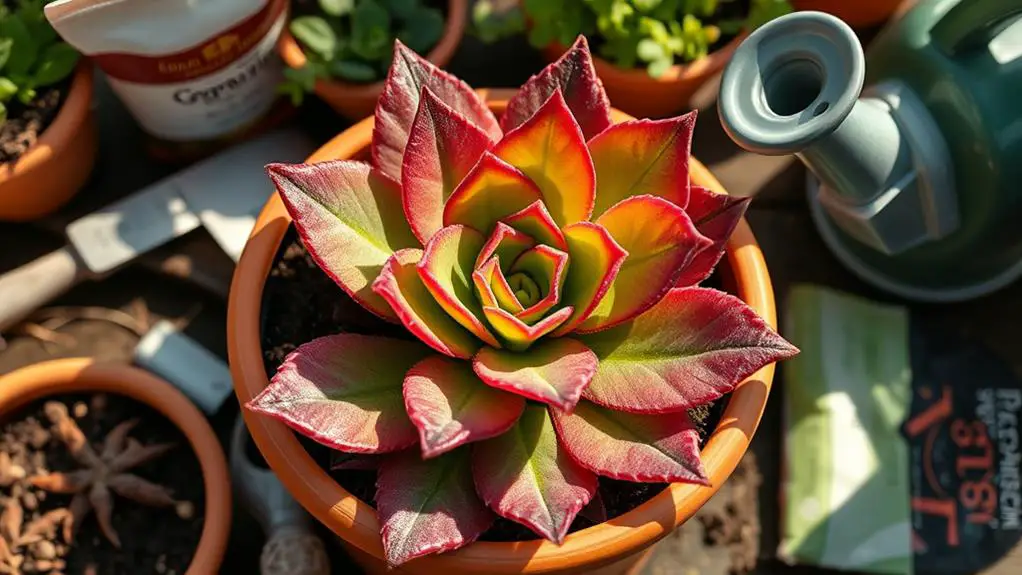
For Graptoveria Fred Ives, fertilization should be kept minimal to maintain its health and vibrancy.
Use a balanced, water-soluble fertilizer once a month during spring and summer. Most potting soils have enough nutrients initially, so repotting every 1-2 years can be enough.
Over-fertilization can cause issues like discoloration and stunted growth, so keep an eye out.
- Monthly fertilization: Use a balanced, water-soluble fertilizer during active growth.
- Repotting: Do this every 1-2 years to provide fresh nutrients.
- Avoid over-fertilizing: Watch for stress signs like discoloration.
- Dormant period: Don't fertilize in winter to prevent stress.
Frequently Asked Questions
How Do You Care for Graptoveria Fred Ives?
Place your Graptoveria Fred Ives in bright sunlight, water every 12 days, and use well-draining soil. Fertilize monthly during spring and summer. Inspect for pests regularly, and address any signs of distress like yellowing leaves.
How Do You Care for a Graptoveria Debbie?
To care for Graptoveria 'Debbie', place it in bright, indirect sunlight, water every 10-14 days when the soil's dry, use well-draining soil, fertilize monthly in spring and summer, and monitor for pests like mealybugs and aphids.
How Do You Care for a Graptoveria Rose?
Place your Graptoveria rose in bright, direct sunlight, ideally near a south-facing window. Water it sparingly, letting the soil dry out completely between waterings. Use a well-draining soil mix and fertilize monthly during the growing season.
How Often Do You Water a Graptoveria?
You should water your Graptoveria only when the top inch of soil feels dry, usually every 12 days. Adjust the frequency based on light and temperature. In winter, reduce watering since the plant needs less moisture.
Conclusion
Caring for your Graptoveria Fred Ives doesn't have to be complicated. With the right soil, proper lighting, and careful watering, you'll see it thrive. Don't forget to check for pests and give it some fertilizer during the growing season. With a bit of attention, your plant will stay vibrant and healthy. Remember, gardening is a journey. Enjoy the process and watch your Graptoveria Fred Ives add beauty and adaptability to your space!

